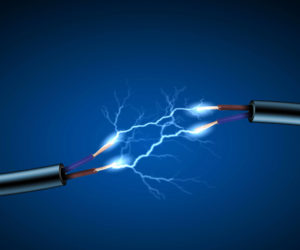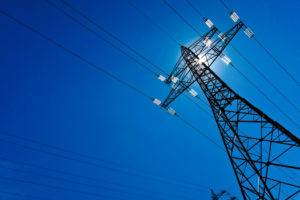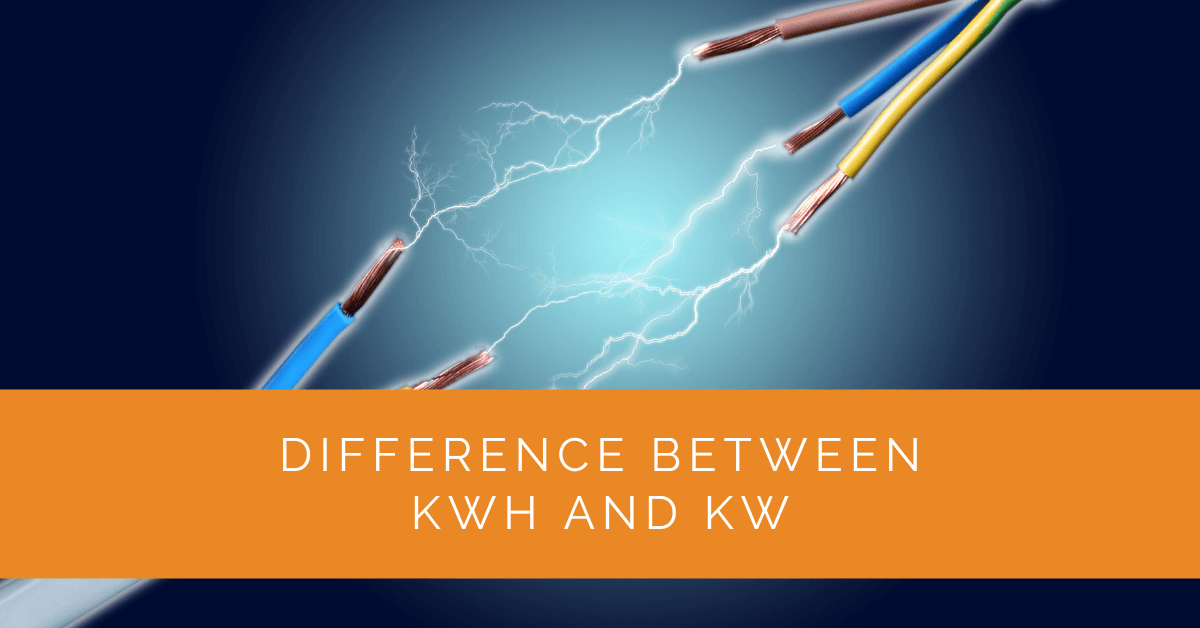In energy consumption and management, grasping the distinction between kilowatt-hours (kWh) and kilowatts (kW) is of utmost importance. As solar panels gain popularity and energy efficiency become a top priority, knowing the difference between these two crucial metrics empowers consumers to optimize their electricity usage and make informed decisions to reduce utility bills.
In this guide, we will delve into the world of kWh and kW, shedding light on their unique roles in measuring power and energy. We will explore practical scenarios, such as interpreting electricity bills and calculating energy consumption for household appliances. By the end of this journey, you will be equipped with the knowledge to become a savvy energy consumer and harness the full potential of your solar panel system. Embrace the power of knowledge as we unlock the difference between kWh and kW, guiding you toward a more sustainable and energy-efficient future.
Contents
- 1 Key Takeaways
- 2 Understanding the Basics: kWh and kW Explained
- 3 The Difference Between kW and kWh in Practical Scenarios
- 4 Case Study: Maximizing Energy Efficiency with kW and kWh Knowledge
- 5 Expert Insights From Our Solar Panel Installers About the Difference Between kWh and kW
- 6 Experience Solar Excellence with Us!
- 7 Conclusion
Key Takeaways
- Kilowatt (kW) measures the energy consumption or production rate, while kilowatt-hour (kWh) represents the total energy used over time.
- Understanding the difference between kWh and kW is essential for managing energy consumption effectively and optimizing electricity usage.
- By implementing energy-saving practices, using energy-efficient appliances, and leveraging solar power, homeowners can lower their utility bills and contribute to a sustainable future.
Understanding the Basics: kWh and kW Explained
What is a Kilowatt (kW)?
A kilowatt (kW) is a unit of power used to measure the rate at which energy is consumed or produced. It is a crucial metric determining the capacity of electrical devices, solar panels, and other power sources. One kilowatt equals 1,000 watts, representing the energy required to perform work at a rate of 1,000 joules per second. In simpler terms, if an electrical device consumes 1 kilowatt of power, it uses 1,000 joules of energy every second.
Understanding the connection between kilowatts and appliances’ energy usage is essential for managing electricity consumption effectively. Household appliances typically display their power ratings in kilowatts, indicating the rate at which they consume electricity. This information helps users estimate how much energy each appliance uses and make informed decisions to optimize energy consumption.
To calculate the power consumption of an appliance in kilowatts, you need to divide its wattage by 1,000. For example, if an appliance has a wattage of 1,500 watts, its power consumption can be calculated as follows:
Power Consumption (kW) = 1,500 watts / 1,000 = 1.5 kW
What is a Kilowatt-Hour (kWh)?
While kilowatts measure power, a kilowatt-hour (kWh) measures energy consumption. It represents the total amount of energy used over a specific period. For instance, if an appliance with a power rating of 1 kilowatt operates for one hour, it consumes 1 kilowatt-hour of energy. This is where the distinction between kW and kWh becomes crucial.
Differentiating between kW and kWh is vital because they serve distinct purposes. Think of kW as the speed at which your car travels, while kWh is the distance your car covers during the journey. kW tells you how fast energy is being used or produced at a specific moment, whereas kWh provides an overall measurement of energy used or produced over time.
The utility company uses kWh to determine your energy usage and calculate your electricity bill. The more appliances you have and the longer they operate, the higher the total kWh consumed, leading to an increased utility bill.

The Difference Between kW and kWh in Practical Scenarios
Grasping the Concept: kW vs. kWh in Your Energy Bill
Understanding the distinction between kW and kWh is crucial when analyzing your energy bill. The bill typically consists of two main components: the energy charge and the demand charge.
- Energy Charge (kWh): This is based on the total energy consumed during the billing cycle, measured in kilowatt-hours (kWh). The utility company multiplies the energy consumption in kWh by the rate charged per kWh to calculate this part of your bill. The more energy you consume, the higher your energy charge will be.
- Demand Charge (kW): The demand charge is based on the peak power usage during the billing cycle, measured in kilowatts (kW). This represents the highest rate of energy consumption in a given time frame. The utility company uses this metric to determine the infrastructure required to meet your energy demands. The demand charge is calculated by multiplying the peak demand in kW by the rate charged per kW.
Understanding how these charges are calculated and how they relate to your energy usage is essential for managing and optimizing your electricity consumption. By using energy-efficient appliances and scheduling high-power activities during off-peak hours, you can reduce both your energy and demand charges, resulting in cost savings on your energy bill.
Assessing Energy Usage: Calculating kW and kWh for Household Appliances
Calculating the power consumption of household appliances is a valuable skill for managing energy usage and estimating electricity costs. Here’s a step-by-step guide to help you calculate kW and kWh for various appliances:
- Identify the Wattage: Find the wattage rating of the appliance. This information is usually available on the product label or user manual.
- Convert to Kilowatts (kW): Divide the wattage by 1,000 to convert it to kilowatts (kW). This step will give you the power consumption of the appliance in kW.
- Estimate kWh Usage: To estimate the total energy consumption over time, multiply the appliance’s power consumption in kW by the number of hours the appliance operates each day. Then, multiply the result by the number of days the appliance is used during the billing cycle.
For example, let’s consider a refrigerator with a wattage rating of 150 watts that operates for 24 hours a day throughout a 30-day billing cycle:
Power Consumption (kW) = 150 watts / 1,000 = 0.15 kW Estimated Monthly kWh Usage = 0.15 kW * 24 hours/day * 30 days = 108 kWh
By following these calculations for all your appliances, you can gain valuable insights into your energy usage and identify potential areas for energy conservation.

Key Factors Influencing Energy Usage and Their Impact on kW and kWh
Several factors influence the energy usage of household appliances, and understanding them can help you manage your electricity consumption more effectively. Some of the key factors include:
- Appliance Efficiency: Energy-efficient appliances consume less energy to perform the same tasks, resulting in lower kW and kWh usage. When purchasing new appliances, look for models with high energy efficiency ratings to save on energy costs.
- Duration of Use: The longer an appliance operates, the more energy it consumes. Be mindful of the duration and frequency of appliance usage to reduce your kWh consumption.
- Seasonal Variations: Weather conditions can impact the energy usage of appliances like air conditioners and heaters. Be aware of how these seasonal variations can influence your energy bill and make adjustments accordingly.
- Standby Power: Some appliances consume energy even when on standby mode. Unplugging or using power strips to turn off multiple devices simultaneously can help you avoid unnecessary energy consumption.
Tips to Optimize Electricity Consumption and Lower Your Energy Bill
You can significantly reduce your kW and kWh usage by implementing energy-saving practices and adopting energy-efficient technologies, resulting in a lower energy bill. Here are some tips to help you optimize your electricity consumption:
- Upgrade to Energy-Efficient Appliances: When replacing your old appliances, opt for energy-efficient models that carry the ENERGY STAR label or similar certifications. These appliances are designed to consume less energy while providing the same level of performance.
- Embrace LED Lighting: Replace traditional incandescent bulbs with energy-efficient LED bulbs. LED lighting consumes less energy, lasts longer, and can save substantial energy.
- Set Thermostats Wisely: Adjust your thermostat settings to ensure your heating and cooling systems operate efficiently. Lower the thermostat during colder months and raise it during warmer months to reduce energy consumption.
- Unplug Devices When Not in Use: Unplug chargers, electronics, and other devices when they are not in use to avoid “phantom” energy consumption. Even in standby mode, these devices can draw power and contribute to your energy bill.
- Leverage Solar Power: Consider installing a solar system on your property to harness renewable energy and generate electricity. Solar panels can significantly offset your energy consumption, leading to substantial savings on your energy bill.
Case Study: Maximizing Energy Efficiency with kW and kWh Knowledge
Background
At Solar Panels Network USA, we believe that knowledge empowers our clients to make informed decisions about their energy usage. One of our clients, a homeowner interested in reducing their energy costs and carbon footprint, sought our expertise to better understand the difference between kilowatts (kW) and kilowatt-hours (kWh) and how this knowledge could be applied to their daily energy consumption.
Project Overview
Our goal was to educate the client on the fundamental differences between kW and kWh, and demonstrate practical applications for managing and reducing energy consumption. This involved a thorough analysis of their household energy usage and the implementation of energy-saving strategies.
Implementation
Initial Assessment
We began with an energy audit of the client’s home, identifying all major appliances and their power ratings. This included noting the wattage of each device, which would be used to calculate their power consumption in kilowatts.
Educational Session
We conducted a comprehensive session explaining the difference between kW and kWh. Kilowatts (kW) were described as the rate of energy usage, while kilowatt-hours (kWh) were explained as the total energy consumed over a period. This distinction was crucial for understanding their energy bills and identifying areas for improvement.
Calculating Energy Consumption
Using the data from the energy audit, we calculated the energy consumption of key appliances. For example, the client’s refrigerator, rated at 200 watts, was found to use 4.8 kWh per day (0.2 kW x 24 hours). This calculation was repeated for all significant appliances, providing a clear picture of total household energy consumption.
Energy Optimization Strategies
With a detailed understanding of their energy usage, we advised the client on several strategies:
- Upgrade to Energy-Efficient Appliances: Recommending appliances with higher energy efficiency ratings to reduce kW usage.
- Smart Usage Practices: Encouraging the use of high-power appliances during off-peak hours to minimize demand charges.
- LED Lighting: Suggesting a switch to LED bulbs, which use less energy (lower kW) and last longer, reducing overall kWh consumption.
- Standby Power Reduction: Advising the use of power strips to easily turn off devices when not in use, preventing “phantom” energy consumption.
Solar Power Integration
We also discussed the benefits of installing a solar panel system. By understanding their peak energy consumption (kW) and total energy usage (kWh), the client could size their solar system appropriately. This integration would significantly offset their energy consumption, leading to lower utility bills and a smaller carbon footprint.
Results
The client implemented the recommended strategies, leading to a noticeable reduction in their energy bills. The educational session empowered them to monitor their energy usage actively and make informed decisions about appliance use and energy conservation. Additionally, the client decided to install a solar panel system, further enhancing their energy efficiency and sustainability.
Summary
By grasping the distinction between kW and kWh, our client was able to take control of their energy consumption. The practical applications of this knowledge, combined with strategic energy-saving practices and solar power integration, resulted in substantial cost savings and a reduced environmental impact. Solar Panels Network USA demonstrated that with the right knowledge and tools, homeowners can optimize their energy usage, lower their utility bills, and contribute to a more sustainable future.
Expert Insights From Our Solar Panel Installers About the Difference Between kWh and kW
Understanding the difference between kWh and kW is critical for homeowners looking to optimize their energy consumption. Kilowatts measure the rate of energy usage, while kilowatt-hours reflect the total energy consumed over time. This knowledge helps in making informed decisions about energy usage and efficiency.
Senior Energy Consultant
Accurately calculating energy consumption of appliances in kilowatt-hours allows homeowners to identify high-energy devices and take steps to reduce their energy bills. This approach is essential for efficient energy management and sustainability.
Solar Energy Advisor
Utilizing solar power effectively hinges on understanding kW and kWh. By knowing how much energy your solar system produces and how much your household consumes, you can better manage your energy usage and maximize savings.
Chief Solar Technician
Experience Solar Excellence with Us!
Trust in Solar Panels Network USA, where our seasoned experts deliver top-quality solar solutions for homes and businesses nationwide. With a legacy of countless successful installations and a commitment to sustainable energy, we’re your reliable partner in the solar journey. Ready for a brighter, eco-friendly future? Call us now at (855) 427-0058 and harness the power of the sun!
Conclusion
Understanding the difference between kWh and kW is fundamental to effectively managing and optimizing electricity consumption. While kilowatts (kW) represent the rate at which energy is consumed or produced, kilowatt-hours (kWh) measure the total energy used over time. By grasping the distinction between kW and kWh, homeowners can estimate energy costs, calculate energy consumption for various appliances, and identify opportunities for energy conservation.
When managing your energy bill, being mindful of your peak power usage (kW) and overall energy usage (kWh) is essential. Implementing energy-saving practices, using energy-efficient appliances, and leveraging solar power can significantly reduce your energy bill and make your home more environmentally friendly.
By becoming aware of how power and energy are measured and how they relate to your utility bill, you can take control of your energy consumption and make informed decisions to optimize energy usage and save on electricity costs. Being energy-conscious benefits your finances and contributes to a sustainable future for our planet.
About the Author
Solar Panels Network USA stands at the forefront of solar energy solutions, driven by a team of seasoned solar engineers and energy consultants. With over decades of experience in delivering high-quality solar installations and maintenance, we are committed to promoting sustainable energy through customer-centric, tailored solutions. Our articles reflect this commitment, crafted collaboratively by experts to provide accurate, up-to-date insights into solar technology, ensuring our readers are well-informed and empowered in their solar energy decisions.

